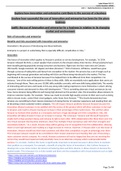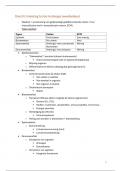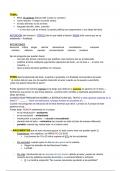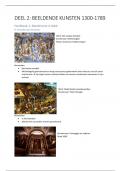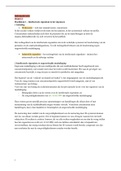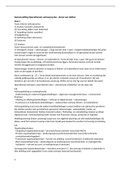PART 1: INNOVATION SYSTEM
Technology and innovation management
✓ Key concepts and insights (economics of innovation, sociology/history of science/technology,…)
✓ What makes innovation different from other economical activities?
1. KEY CONCEPTS
Rising importance of innovation since late 90s major driver of competition/value creation
Robert Solow (1957): knowledge production functions
• Traditional production function – value in economy with educated people and capital
→ 𝑌 = 𝐹(𝐿, 𝐶) with L = Labor, C = Capital e.g. Cobb-Douglas 𝑌 = 𝛼𝐿𝛽 𝐶 𝛾
• Explanatory power (R²) of model jumped from ± 20% ± 80% when including R&D
→ 𝑌 = 𝐹(𝐿, 𝐶) ∙ 𝐴(𝑇) with A(T) = a technological progress parameter
e.g. evolution R&D expenditures, patent output, etc.
Why innovation? new products create value for company and shareholders
• Evidence at firm-level e.g. 3M, Intel, Apple, Philips, Google, Nintendo …
the ones that survive, are the ones that innovate
• Evidence at geographic level = clusters and networks e.g. Silicon Valley, Cambridge …
highest income levels in regions characterized by innovation + entrepreneurship
• Evidence at (supra)national level e.g. OECD data
o on total factor productivity (TFP) + economic growth
o on R&D spending (± 2-3% GDP)
Different disciplines that contribute to understanding innovation dynamics
- Economics: economic impact, market structure antecedents, innovation policies
- Sociology: scientific/technological processes, group dynamics, institutional context
- Management: strategic + operational process, organiz models, innovation metrics
- Psychology: career dynamics, work climates for productive innovation, creativity
- History: case study analyses
The innovation funnel: takes ≈ 3000 raw ideas to produce 1 new + successful commercial product
→ innov process funnel = ≠ ideas going in wide end >< very few make it through developm process
! Try to distinguish bullshit from real feasible promises
e.g. electrical car ≠ happening soon < cost is too high = same problem as with hybrid car (1898)
1.1 Schumpeter (1912)
2 types of agents
Exceptional individuals (entrepreneurs): willing to face hazards + difficulties of innovation
“Heroic”: bringing something new = difficult (uncertainty, complexities, resistance)
Imitators: merely routine managers following in the wake of heroic pioneers
1
, Evolving theory of Schumpeter
1928 SCHUMPETER-I
I. Theory of heroic entrepreneurship + creative destruction as engines behind business cycles
- Entrepreneurs = destabilizing agents change current relations/techniques production
- They lead the economy toward a better use of capital and knowledge
= vital for macroeconomic growth and rising productivity
- Act of inventing act of innovating/risk bearing (due to uncertainty)
!! Not part of his function to ‘find’ or ’create’ new possibilities
→ these are always present, largely accumulated by all sorts of people
CONCLUSION: exogeneity of science and technology
1942 SCHUMPETER-II
II. Big companies still able to innovate Schumpeter changed his mind
- Recognition that in large firms innovation = bureaucratized
- Organized/specialized R&D departments increasingly important in innovation process
e.g. development engineer in R&D dep of electrical firm could be an “entrepreneur”
= INTRApreneur – create new technologies for one’s business/firm
- 2 types of players: entrepreneurs and large firms
→ large established companies would outperform and scale out the entrepreneurs
CONCLUSION: model changes science still outside economy (not market oriented actors)
!! BUT: a lot of technology is now internalized
1.2 Baumol (2004)
“If you want to understand innovation dynamics, you have to take into account multiple actors”
Distinction between the entrepreneur (partner of the inventor) large established firms
= building on the ideas of Schumpeter
3 QUESTIONS
1) Who is really responsible for innovation and related new economical activities?
e.g. new entrepreneurs/entrepreneurial firms or large established firms?
2) If both contribute, is the nature of the contribution similar?
3) If contribution economical actors, can we explain a complete picture ito innovation dynamics?
2
,ANSWERS
1) Heroic entrepreneurs driving the jumps in wealth/productivity e.g. Musk, Zuckerberg,…
Economic growth = story of shocks – invasive activities
→ get into new temporary state of equilibrium (hopefully higher than previous)
Pioneering new technologies, business models, etc. = driver wealth + profitability
BUT: also destroy/replace many other companies = creative destruction
→ process results in in economic welfare
Certain countries (USA) seem to do better at encouraging entrepreneurs
Entrepreneurial deficit in Europe?
It is not about having that breakthrough technology (scientists/inventors)
= about entrepreneur translating technology into market (≠ skill but will)
? If entrepreneurs are the only ones creating growth, how to explain Apple?
• Started in 1982 → in 1990s saved from bankruptcy by a loan of Microsoft
• Problem = integration hardware and software locked in (package deals)
IBM’s open source approach free to choose operating system
• Microsoft had a dominant position = 93% market share
→ used it to push other software related products accused monopolist
• Apple had 2nd largest share = 5% BUT: were targeted at general public
→ couldn’t program here so Microsoft benefited from combining forces
2) According to Baumol, Schumpeter was wrong ito outperformance and replacement
Both types of actors remain present – albeit focusing on ≠ contributions
Small, entrepreneurial firms: creating ‘breakthroughs’
Large, routinized firms: creating aggregated incremental improvements
In the end big pockets will dominate innovation scene – not really happening
→ Big companies not always able to translate resources into new technology
e.g. how does Tesla dominate in electric car industry? – large firms are catching up
3) Baumol (+ others): both government and universities play important roles as well
Provide legal framework conditions encouraging entrepreneurships + R&D investm
Create framework/rules for IP rights + enforceability of contracts
Support basic research – see market failures
introduce universities (+ other public research agencies) as engines of novelty
1.3 Abernathy & Utterback (1978)
Complementing Baumol’s assessment: “Patterns of Industrial Innovation”
Start from a “productive unit” = a product line + associated process ( industry classifications)
• Its capacity for and methods of innovation depend on its stage of evolution
• Industry dynamics central role of product life cycle industry life cycle (Schumpeter)
! Same pyramid pattern always came back: entrance peak #companies
Introducing a time dimension (dynamic perspective) technology lifecycle with 3 phases
3
, Abernathy and Utterback’s three phases of innovation (1975)
1) Fluid: addressing a demand in the market → money can be made → entrance
→ a lot of product innovation in this stage
2) Transitional: “entrance of a dominant design” = after a while emerging of dominant design
- This product/design gets standardized
- Winning the race against electrical/hybrid car because too expensive then
- Combination of functionality + price tag that decides dominant design
→ price is still preventing the electrical car from becoming dominant
3) Specific/mature: in product variety = market more homogeneous → saturation
- Start operating at larger scale (economies of scale) #companies
= best car at most reasonable price by the company able to produce more units
- Concentration / scale enlargement continues over time
e.g. Saab left the market – not able to sell enough cars to set up production
- 2 options: scale yourself or sell otherwise you’ll be kicked out
- Product innovation → Process innovations = technologies to become more efficient
? Who decides what becomes the dominant design customers & the market
e.g. bike with big tires – especially attractive for youth (needs muscles to ride/climb onto)
• Bicycle should be forbidden (its dangerous)
• We get a discussion regarding the new product/technology introduced in the market
• Conditions are being created for the agreement of a dominant design to emerge
What helped in one specific bicycle becoming the dominant design? = rubber tires
Conflicting demands: speed safety – rubber tire allows to combine both
→ innovation settled with debates
e.g. Uber and AirBnB
• Amsterdam: discussion about introducing legislation surrounding AirBnB
→ it has negative effects of development of the city
• Discussion about danger of Uber taxis – no market development
• Development of technology + what is being accepted (and conquering the world)
= highly social process with many social groups
Final result = social negotiation process (legitimate operation of model in the market or not)
Innovation and experimentation = very important
4


